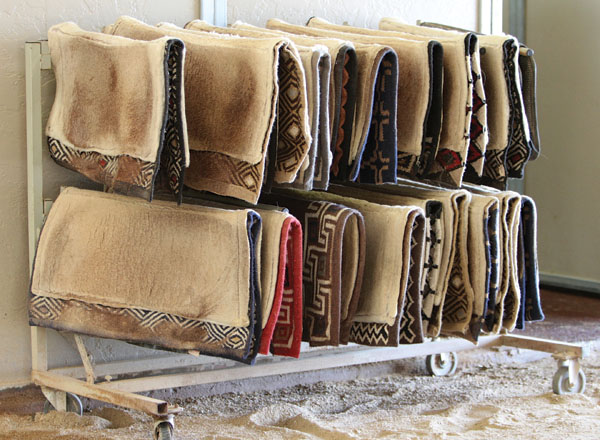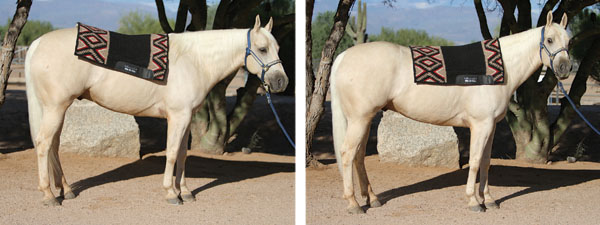Your Western saddle pad protects your horse’s back by absorbing and distributing pressure from the weight of you and your saddle. A clean, dry pad also dissipates heat and wicks moisture during your ride so your horse stays cool. While fun colors, patterns, and other trends help you personalize your turnout, it’s more important that your pad’s situated properly under your saddle and that it can protect and cool your horse. A comfortable horse is more able and willing to do his job, making a more enjoyable experience for you both. When your horse is disagreeable to ride for no apparent reason, he’s trying to tell you something. An unhappy horse loses his attention, pins his ears, twitches his tail, or tries to bite at the saddle as you tack up; if you see this, adjust your tack to keep him happy.
[READ: Be Trail-Tack Savvy]

Here you’ll learn how to select and place your Western saddle blanket, and maintenance tricks to keep your equipment in tip-top condition.
Fit and Placement
To ensure that your horse is outfitted correctly, consider these factors as you select your Western pad.
Saddle fit is the foundation to a proper setup. Even a well-padded, well-fitted blanket with all the latest features can’t do its job if the saddle’s tree doesn’t fit your horse’s back. Barring unusual conformation, a horse’s sweat patterns underneath his blanket should be even. If when you remove your saddle after a ride you see unusual dry spots, either your saddle doesn’t fit properly or your pad’s worn out. Find a trusted saddle fitter to get help, or start shopping for a new saddle pad. If you’ve already consulted experts, consider how your riding or your horse’s conformation could affect how his saddle fits, and adjust as needed. It could be that your seat is off balance.
Pad thickness affects how your saddle sits on your horse’s back while you ride. A thick pad on a horse with a round back or mutton withers will allow the saddle to move during your ride because there’s no space for your saddle to rest against his withers. Instead, choose a thinner pad that’ll form to his back. A horse with a swayed back or high withers needs a blanket that’s built up or has more fill to better distribute the saddle’s weight and pressure. A good-fitting saddletree is always the best solution.
Pad placement is next. It’s as important that your pad’s properly placed and centered on your horse’s back as it is that your saddle’s on correctly.
[READ: Pre-Ride Tack Check]

Your pad should sit up on your horse’s withers to protect them. Place your blanket such that if you were to draw a line vertically from the middle of his forearm muscle, the front of the pad aligns with this line. From there, adjust for your horse’s conformation and your saddle’s fit. Place the saddle on your pad so the girth sits just behind your horse’s front leg—at his heartgirth. Equal excess pad showing on both sides and to the front and rear of your saddle protects his back. Check that your pad’s placed in the correct direction, with the wear leathers facing forward and the withers protector on his withers. Adjust your cinches evenly on both sides of your saddle with correct tension to keep your pad in place and your horse comfortable.
Material
Choose blanket materials to suit your ride’s length and purpose. I prefer a pad that conforms to my horse’s back, so use the contoured, wool blankets seen in these photos. But, there are other pads that’ll meet your needs and horse’s preference just as well. Be aware if your horse has an allergic reaction to a particular material, and don’t use it in the future.
Fleece is a popular material used as the base of woven, decorative pads, or for the entirety of a blanket. Synthetic fleece is more durable than genuine wool fleece, and doesn’t matt and compact as quickly. However, it’s not as cushioning as 100-percent wool fleece. Both are evaporative and breathable to dissipate heat from your horse’s back. Over time it conforms to your horse’s back to allow your saddle to sit in place. This means it’ll need washed and fluffed so it doesn’t flattened to the point that it’s no longer useful.
Felt is similar to fleece because it cushions, breathes, and wicks moisture. Felt is available in several materials. Genuine wool is most expensive, while wool/synthetic blend is more affordable and serves the same purpose. Because felt is compacted, it doesn’t breathe as nicely as fleece does; however, it’s thicker and more cushioning.
Neoprene is the easiest to maintain and has a tacky surface that keeps it from sliding. Its thickness and ability to maintain shape cushions your saddle well against your horse’s back, but at the expense of heat dissipation. Unless it’s waffle-patterned, which encourages airflow, neoprene causes your horse to sweat easily. It also doesn’t conform to your horse’s back, so unless it fits well, it’s likely to have more play over his shoulders. Neoprene’s easy to maintain; a quick rinse at the end of each ride does the trick.
Other synthetics such as open- and closed-cell foam and gel distribute your saddle’s weight across your horse’s back to alleviate pressure spots. These are commonly used on horses with troublesome toplines, such as those with swaybacks; mutton withers; or high, bony withers. Use these to make slight adjustments for an already well-fitted saddle, not to compensate for poor saddle fit. Specially designed, therapeutic blankets are often more expensive in the long run than finding a different saddle.
[READ: Good Everyday Riding Gear]
Care
Diligent saddle-blankets care allows them to last several years and many rides, so invest in a good one. When your pad loses its fill, or you can’t wash and brush it so it returns to its original shape and softness, then it’s time to replace it. Replace neoprene when the material tears, cracks, or hardens.
Maintain your pad regularly and allow it to air dry before storage. If possible, store your pad upside down on a rack until the next use. Set your pad out in the sun to dry rather than throw it in a dryer. Sun kills bacteria on the blanket, whereas a humid dryer encourages growth. Remove accumulated hair, dirt, and sweat from a neoprene pad with a quick rinse. For a deeper clean, take your blanket to a do-it-yourself car wash to pressure wash. Some pads, such as the ones photographed, are washing-machine safe.
After the pads have completely dried, use a clean curry to fluff the material. If you’re concerned about the durability of the pad or worry that the dyes of your show rug will fade, consult your blanket’s manufacturer or the attached tag for cleaning instructions.
Al Dunning, Scottsdale, Arizona, has produced world champion horses and riders in multiple disciplines. He’s been a professional trainer for more than 40 years, and his expertise has led him to produce books, DVDs, and his own online mentoring program, Team AD International (teamadinternational.com).

